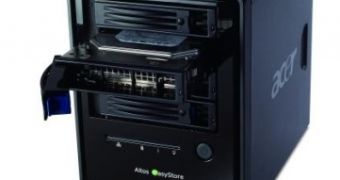Acer, world's third largest PC vendor has introduced its newest update to the easyStore collection: the Altos easyStore. The intelligent data storage device is targeted at small- and medium-businesses, but it is also suitable for home networking environments.
The storage device is easy to set up and deploy, and, upon successful installation, it will provide up to 3 TB of storage capacity on maximum four high-capacity hard disk drives. The device can be set up through a simple and efficient web-interface, that allows the user to configure the storage options in any RAID configuration (0, 1, 5, 10, and JBOD).
The Altros easyStore can be used in a variety of operating systems, such as Microsoft Windows, Mac and Linux. The device perfectly integrates into the network and is the ideal tool for companies or enterprises that are data intensive. The wide range of RAID configurations can provide a redundant copy of the data, in order to ensure that you won't lose valuable information.
The easyStore users can schedule automatic tasks to get executed occasionally, such as automatic client backup. Regular data backups are extremely important, especially at the corporate level. The device can also protect the data using RAID Levels 5, 10 and 1 support, as well as user name or group level of password protection.
The storage device can offer easy file sharing between the computers on the network, as well as up to 2 TB of shared storage space. The easyStore can also manage shared folders by users names or groups, with additional management security.
Altos ships with client backup and recovery software, but it only can be used with clients running Windows operating systems. Recovery from disk failure, file corruption or virus attacks can be easily performed in order to minimize the downtime. Moreover, Acer's Altos easyStore supports PXE boot options, which allows the clients to be booted directly from the backup copy storage system and then recover the system disk.

 14 DAY TRIAL //
14 DAY TRIAL //